ERP software development simplifies a wide range of tasks for business owners, like inventory & order management, accounting, manufacturing, and much more.
Updated 8 April 2024

CEO at Appventurez
Are you struggling to streamline your business processes efficiently? If yes, integrate ERP software development into your business strategy. With the help of ERP system integration, you can unfold countless opportunities for your business, promoting efficiency, productivity, and innovation.
Traditional practices, like Excel spreadsheets for storing the data no longer excite business owners as integrated ERP solutions offer them a comprehensive toolkit. As a result, businesses can stay competitive by optimizing their operations and driving growth – all thanks to ERP software development.
A software product development company embracing different ERP systems, like Cloud, Hybrid, and open-source ERP, helping businesses in the lucrative market. Custom ERP software development has been a transformative approach ever since its existence.
But, what exactly ERP system development is, and how it can revolutionize the ways of elevating business growth?
In this extensive guide to ERP software development, we will walk you through its intricate landscape, which will include enterprise resource planning examples, its key features, different types, and the process used for developing an ERP system.
For starters, the term ERP stands for – Enterprise Resource Planning. It is simply a software toolkit leveraged by entrepreneurs and well-established business owners to manage all the paperwork – from accounting and logistics to sales and marketing.
ERP app development came out as a successful approach as it saves a lot of time and money by automating the employee’s routine tasks. As per the reports shared by Statista, the Enterprise Resource Planning Software market is projected to reach $52.33 billion by this year (i.e., 2024), and in the next four years, the annual growth rate will increase by 4.48%.
In fact, the implementation of advanced technology services, like machine learning and AI development services boosts ERP software development. With the help of algorithms and previous data, ERP systems can predict future outcomes, like inventory demand, equipment maintenance, and many more. Additionally, these technologies help in identifying thefts and detecting any fraudulent activities.
There are numerous benefits of ERP systems, helping businesses have an organized workflow with complete efficiency and enhanced productivity. From standardized data and compliance support to scalability and better customer service, enterprise resource planning can benefit you in multiple ways.
Here is a list of top benefits that you can leverage from ERP software development:
Easy maintenance is one of the primary benefits of ERP as the software has a vast community support team, who can identify bugs in the system and resolve them on time. During the risk of any bugs or glitches entering the system, you can instantly contact their team before it hampers the entire ERP software development.
Another advantage of ERP software development is the ability to explain any concept that is exclusively developed for your company rather than a whole community. Developers provide comprehensive documentation, explaining every concept from basic to advanced level, which results in a quick training process.
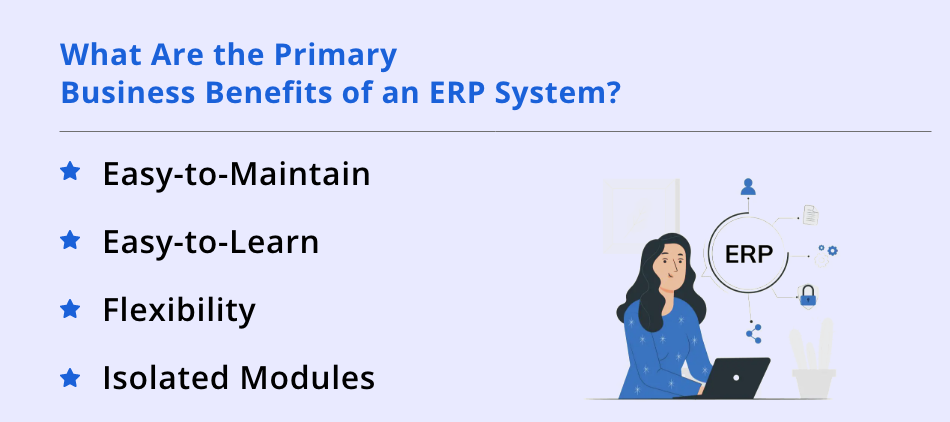
ERP software development is considered highly flexible because it is easily adaptable to a wide range of business requirements and changing environments. The system provides custom-made modules, configurable workflows, and scalability to fit in with increasing growth. In other words, ERP is useful as it quickly and effectively responds to market trends.
Last but not least – isolated modules, enable business owners to create various modules that are specifically designed as per the business’s requirements. Employees or ERP software vendors have the ability to easily grant safety and reduce the risk of data leakages.
Here are 5 core examples of integrated ERP software that can improve your business efficiency and productivity.
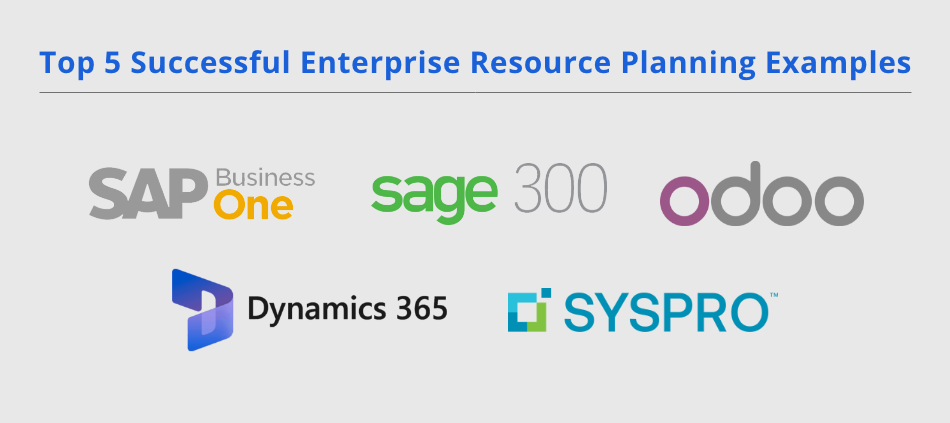
The first ERP example that enables users to pick the most appropriate features for their software as per the company’s needs is Microsoft Dynamics 365. Users can avail services for marketing, sales, or operations, and each service requires the app to perform respective tasks. For instance, marketing tools will have apps for B2B and B2C marketing, and operations tools, on the other hand, include supply chain and inventory management applications.
Another ERP software development example is Sage 300, used by small and medium-level businesses across a wide range of industries, including professional and retail services. Each program uses a different set of modules, allowing users to purchase a custom-made platform integrated with core functionalities. Some of the prominent modules include financial and operations suites, supporting multiple languages.
SAP-enabled tools in ERP integration are useful for small-scale business owners from different industry verticals, enabling users to customize the program as per their requirements. With the help of this ERP software, entrepreneurs can see the complete operating structure of their organization, ranging from finance to operations. It helps them set the company’s strategic growth target. Additionally, this tool monitors Key Performance Indicators (KPIs).
If you want to complete multiple business tasks, like financial planning, operational monitoring, sales, and marketing effortlessly, Odoo is the suitable tool for you. It is an open-source business management software backed with ERP capabilities. With the help of this tool, developers can also build the company’s websites and other advanced technologies.
Last but not least, Syspro provides innovative ERP solutions to companies of all sizes for industries, like manufacturing and distribution. It delivers customized solutions to specific industry sectors, like automotive manufacturers, plastic firms, food & beverage distributors, etc. Syspro is integrated with multiple business operations, like finances, operations, and IT, and it also shows support to different distribution requirements, like inventory, transportation, etc.
The integration of essential ERP software features serves a variety of purposes to streamline and optimize business processes.
Let’s look at some of the key features that make ERP more useful.
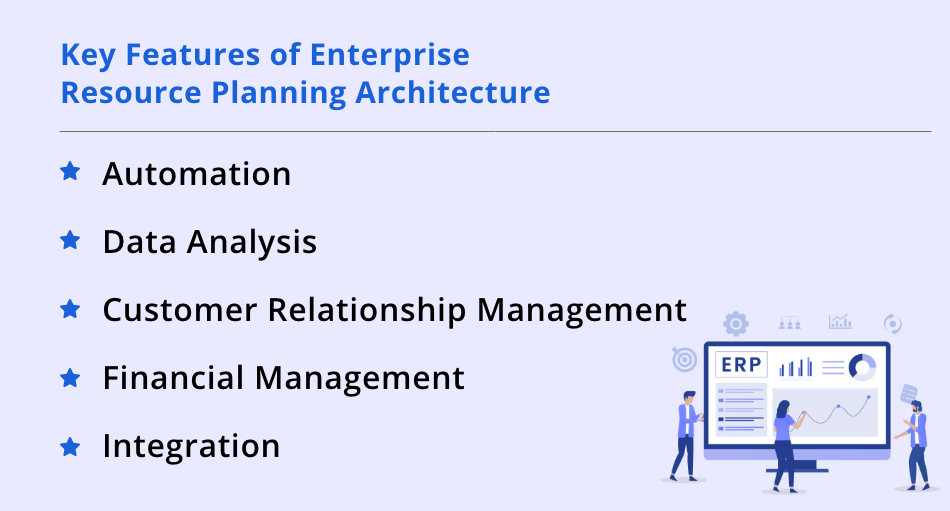
One of the most important features of commercial ERP software development is automation, which reduces the manual task, like payroll, invoice, and order processing. Automation not only makes the task easy but also reduces the duplicity of data entry and manual work, resulting in saving time and reducing errors. This way, employees are able to focus on the important tasks.
The integration of data analysis in ERP software development provides companies with valuable insights into their operations, enabling them to make well-informed decisions. For instance, if you are analyzing the data on sales or finances, you can identify the latest trends, better opportunities, and areas of improvement.
Next up, we have CRM development services that give integrated toolsets to manage the customer’s data and track their overall journey. Building a CRM system will give you an overview of prospects to make the most out of sales, marketing, and customer services. Developing customized ERP software with CRM capabilities minimizes the time of managing customers, assisting with customers’ upselling, etc.
Another feature that is required in the development of ERP system is financial management, which has a crucial role in making better spending decisions, managing assets, and making accurate financial reports. With the help of this module, businesses can easily monitor and maintain any financial data.
The ERP system integration enables you to easily connect with other applications or systems, which further helps in improving insights and productivity. ERP software development has the potential to interact with every single application existing in the same ecosystem or other business software.
Enterprise Resource Planning is categorized into three major types – on-premise ERP, cloud-based, and hybrid ERP, tailored to various industries irrespective of their sizes and requirements.
Let’s read about them one by one:
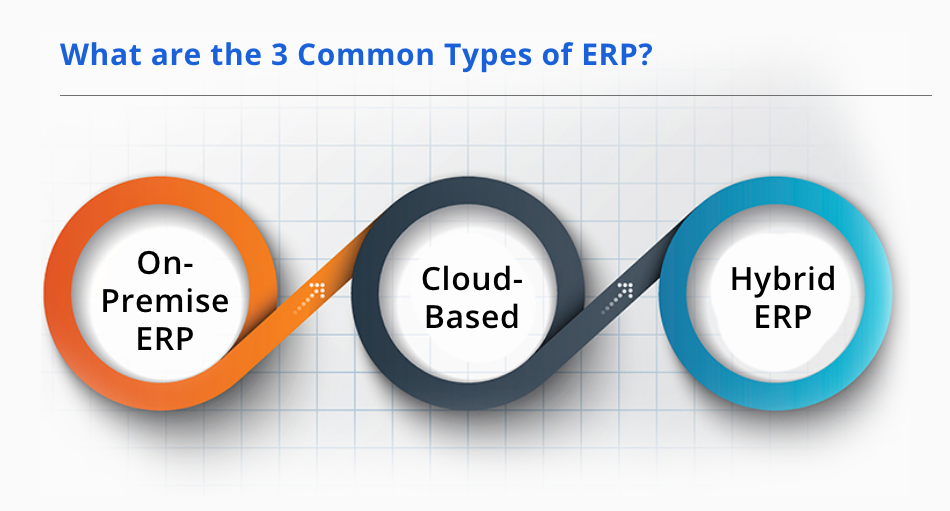
On-premise is the first type of ERP software development that is installed and maintained by the company’s own server and infrastructure. It gives complete control over data and processes with minimal yet significant upfront investment and ongoing maintenance.
Also known as Software as a Service (SaaS) ERP, hosted by Cloud, allows users to have remote access through good internet connectivity. Cloud-based ERP offers robust scalability, and flexibility, and reduces the upfront cost.
Here comes the combination of on-premise and cloud-based solutions – hybrid ERP. It is an effective approach that ensures smooth data flow and interoperability between different systems. Hybrid ERP offers scalability, letting organizations scale their operations flexibly.
When looking for ERP software development, business owners get two options – custom-made solutions and third-party solutions. Choosing between these two approaches, entrepreneurs must weigh several factors to determine the most suitable option.
Third-party software solutions have in-built systems that are cost-effective and quicker to deploy. There are various kinds of third-party services available, like Acumatica, Sage Intacct, and SAP Business One, these three are suitable for small and mid-level businesses.
Additionally, these parties stay updated with the latest industry practices, providing standardized workflows and features that align with common business processes.
On the other hand, customized solutions offer tailored functionalities in order to fit the company’s requirements, offering a competitive advantage and potentially higher ROI. However, it still requires significant upfront investment, longer development timelines, and ongoing maintenance.
Ultimately, the decision depends on various factors such as budget, timeline, scalability needs, and the level of customization required to optimize business processes.
Now, that we have covered almost everything, it’s time to focus on the most important question – “How to build an ERP system?”
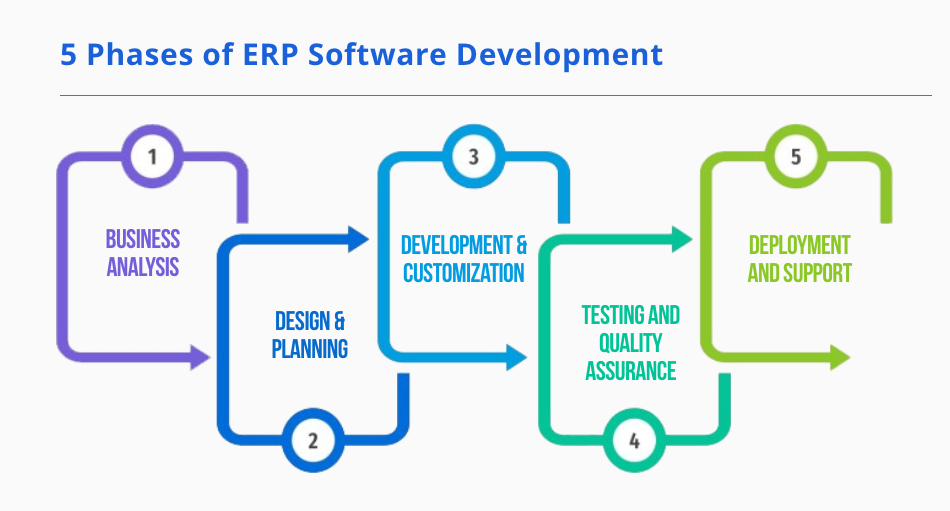
To begin with the ERP software development process, focus on understanding the business requirements & objectives that your project needs to fulfill. Here, you can conduct interviews with stakeholders, analyze the existing processes, and document the current workflow.
The goal of business analysis is to identify pain points, inefficiencies, and areas for improvement that the ERP system can address. Deliverables may include a comprehensive requirements document, process flow diagrams, and a feasibility study.
Once the requirements are gathered, the next step of the ERP process is to design the architecture and functionalities of the system. This phase involves creating detailed design documents specifying the database schema, UI design services, system modules, and integration points.
Planning also includes resource allocation, budgeting, and timeline estimation for the development process. The outcome of this phase is a blueprint that serves as a roadmap for the mobile app development company.
In this phase, the actual coding and customization of the ERP software development take place.
Developers write the code according to the design specifications, integrating various modules and functionalities.
Customization involves tailoring the ERP system to meet specific business requirements that may not be addressed by standard features. This phase requires collaboration between developers, database administrators, and other relevant stakeholders to ensure smooth implementation.
Availing of mobile app testing services is crucial because it ensures that the ERP software meets the specified requirements and functions correctly. Various testing techniques such as unit testing, integration testing, system testing, and user acceptance testing are employed.
Quality assurance activities involve identifying and fixing defects, ensuring data integrity, and validating performance and scalability. The objective is to identify and rectify any issues before deployment to minimize disruptions to business operations.
Once the ERP system has passed testing and quality assurance, it is ready for deployment.
Deployment involves installing the software, configuring settings, migrating data, and training end-users. Post-deployment support is essential to address any issues, provide technical assistance, and ensure a smooth transition and adoption.
Ongoing support may include software updates, bug fixes, user training, and system maintenance to keep the ERP system running efficiently. As a result, you will have to pay extra for an app maintenance cost, which will be worth the investment.
Overall, these phases are essential for successfully developing and implementing ERP software, ensuring that it aligns with business objectives, meets user requirements, and delivers value to the organization.
The ERP cost is not definite because there are a wide range of factors impacting the overall pricing. For instance, the number of users & features you want in your EEP software development, maintenance, upgrades, process redesign, technological additions, and most importantly, development hours required to build an ERP system.
Here is a complete breakdown of the ERP software development cost based on the project type:
| ERP Type | ERP Implementation Cost |
|---|---|
| Basic-Level | $30,000 to $1,00,000 |
| Mid-Level | $1,25,000 to $2,50,000 |
| Complex-Level | $2,50,000 and above |
Overall, the cost of an ERP system will be worth your investment.
Here at, Appventurez, we have a team of professional developers, who leverage their requisite knowledge to build scalable ERP solutions based on the client’s requirements. We empower businesses by providing customized solutions using cutting-edge technologies, starting from – strategy making to production.
Besides providing ERP solutions, we provide other wide range of services, including Android app development services, custom iOS app development solutions, Flutter app development services, and many more.
So, embark on a streamlined journey, maintaining your business’s efficiency and productivity through ERP software development.
Q. What is an ERP system?
The term ‘ERP’ stands for – Enterprise Resource Planning. It is a software development used by entrepreneurs to streamline their business processes for improved efficiency & productivity.
Q. What are the key components of an ERP system?
ERP system consists of a wide range of modules varying from various industry verticals, like finance, supply chain, inventory management, customer relationship management (CRM), HR, etc.
Q. How to use ERP?
Here are some of the tips & tricks you can leverage to make the usage of ERP more effective – get insights into business processes > offer effective training > manage & track the data > think of integrated platforms > consult the expert team
Q. How to build an ERP from scratch?
To build an ERP from scratch, define the company’s goals, drive user-friendly UI/UX design, pick the right ERP technology stack, integrate ERP modules, and hire the right tech partner.
Q. How much does ERP implementation cost?
On average, the ERP software development cost ranges between $30,000 to $3,50,000, depending on the business requirements and project complexities.


Elevate your journey and empower your choices with our insightful guidance.

CEO at Appventurez
Ajay Kumar has 15+ years of experience in entrepreneurship, project management, and team handling. He has technical expertise in software development and database management. He currently directs the company’s day-to-day functioning and administration.
You’re just one step away from turning your idea into a global product.
Everything begins with a simple conversation.